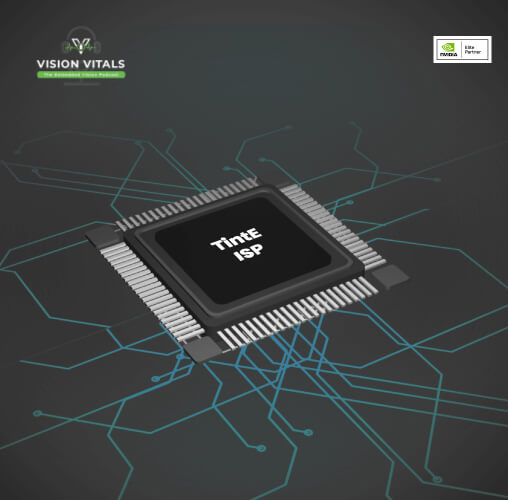Welcome back to Vision Vitals, the podcast where we break down the key technologies powering embedded vision.
In today's episode, we're talking about TintE ISP, e-con Systems' in-house image signal processor that runs on FPGAs and delivers advanced image quality for camera systems.
Let's walk through why it matters and how it's impacting the world of futuristic vision with our guest speaker.
Hi. Glad to be here. TintE ISP is an important subject because it decides whether images are clear, consistent, and suitable for real-world use.
Let's start with the fundamentals. Why does a camera system even need an ISP?
Speaker:
A sensor produces raw Bayer data, which by itself is incomplete. An ISP processes that data to deliver images that are accurate and usable. TintE applies steps such as debayering, auto exposure, auto white balance, tone mapping, and color correction. Without this pipeline, even advanced sensors cannot produce reliable results.
Host:
That makes sense. But why did e-con Systems decide to create TintE instead of relying on standard ISP blocks?
Speaker:
Most ISPs are fixed function and lack flexibility. They may work for certain conditions but fail to adapt across different cameras and applications. TintE was built as a turnkey IP core running on FPGAs.
This means it can be customized and tuned in real time. It gives camera systems the flexibility to handle a wider range of imaging conditions without compromising performance.
Host:
So when it comes to image quality, how does TintE stand out?
Speaker:
TintE provides a complete chain of advanced algorithms. Noise reduction maintains clarity in low-light situations. HDR balances bright and dark areas in the same frame. Debayering ensures accurate colors.
Auto white balance and auto exposure adapt to changing lighting. Lens shading correction, gamma correction, and edge enhancement refine the final output. Together, these functions produce consistent, high-quality images across conditions.
Host:
And is TintE only about visual quality, or does it also influence overall system performance?
Speaker:
It influences both. Normally, intensive image processing tasks place heavy demand on CPU or GPU resources. TintE handles them on the FPGA. Such offloading lowers the load on the main processor, leaving more headroom for higher-level tasks like AI inference or analytics.
As a result, systems achieve stronger imaging performance without sacrificing processing power.
Host:
What about TintE as an IP core itself? What makes it unique compared to other ISP options?
Speaker:
Three things stand out.
- First is modularity. TintE can scale depending on the application, from 4K at 60 frames per second to lower resolutions.
- Second is compatibility. It supports leading FPGA platforms such as Lattice, Xilinx, and Intel.
- Third is customization. The ISP pipeline can be tuned in real time to match application requirements.
This powerful combo of flexibility, efficiency, and broad support distinguishes TintE from conventional ISP solutions.
Host:
Can you give some real-world examples of where TintE has the most impact?
Speaker:
In robotics, TintE enables reliable vision for navigation and object detection. In industrial automation, it ensures that inspection cameras detect defects accurately and at high speed. In medical imaging, it provides clarity under demanding lighting conditions.
In retail or edge AI, it delivers stable video streams for analytics and monitoring. Each of these areas depends on consistent, real-time imaging, which TintE was designed to deliver.
Host:
And how approachable is TintE for teams building vision systems?
Speaker:
It is pretty straightforward. TintE is offered as a complete turnkey pipeline, which means teams do not need to assemble separate modules. It integrates directly into camera systems and remains flexible enough to adjust for different use cases.
For developers, this reduces engineering effort, shortens integration cycles, and speeds up time to market.
Host:
Before we close, I want to touch on something very topical. How does TintE connect with e-con Systems' Jetson Thor-based AI Compute platform?
Speaker:
Our robust ECU accelerated by NVIDIA Jetson Thor delivers up to 2070 FP4 TFLOPS with 128 GB of high-bandwidth memory. The important link is that it integrates seamlessly with multiple sensors while pairing with e-con Systems' Holoscan cameras and TintE ISP.
This ensures superior image quality, optimized processing, and real-time multi-sensor performance in demanding environments.
Host:
That gives us a clear picture. Thank you for breaking down TintE ISP and showing why it is such a crucial element of embedded vision systems.
Speaker:
Always a pleasure.
Host:
And to everyone listening, if you'd like to learn more about TintE ISP and see how it strengthens camera applications across industries, please visit www.e-consystems.com.
Of course, don't forget to subscribe to our channel so that you don't miss the next episode of Vision Vitals.
Until then, let's keep learning, experimenting, and moving forward.
Have a great week, folks!
Close Full Transcript



 Mr. Thomas Yoon
Mr. Thomas Yoon +82-10-5380-0313
+82-10-5380-0313










